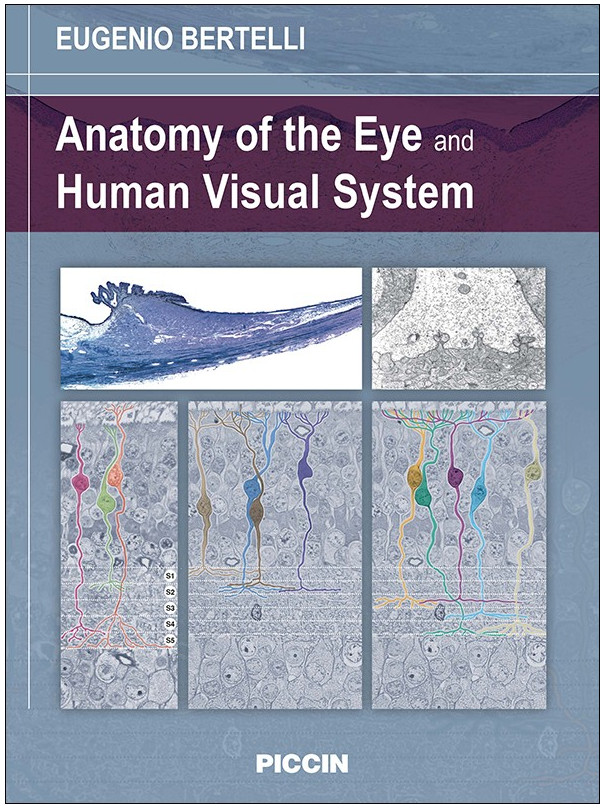Anatomy of the Eye and Human Visual System
Eugenio Bertelli
98,00 €
Foreword
I remember the day I fi rst met Professor Eugenio Bertelli, while I was headed to the Ophthalmology Clinic at the University of Siena, the same University where I was trained. He was interviewing the fi rst year residents of ophthalmology for the eye anatomy annual in-training examination. His strong and fi rm stance immediately impressed me.
Interestingly, I had carried out the same assignment until the previous year, as my fi rst academic appointment was as Professor of Ocular Anatomy for the Ophthalmology Residency Program at Siena University. After years of university career in Siena, I became the chair of the Ophthalmology Department at the Hospital of Grosseto. Th is new position was counted for a “promotion” in the didactic activity: I continued to serve as Professor in the Ophthalmology Residency Program, no longer teaching Ocular Anatomy but Ocular Surgery. Th ough I was happy with this “promotion” at that time, today I am consciously certain that the comprehension of anatomy is fundamental to understand and develop the surgical strategies, to fully comprehend the post-op sequelae, and to grasp the indications to the new techniques. Th e knowledge of the anatomy and its functional implications is indispensable, and
it was crucial in my career. Th e correct knowledge of ocular anatomy is the fi rst milestone on which to compose one’s education.
Th e new textbook by Professor Eugenio Bertelli is complete, accurate, and it off ers an exhaustive iconography. It is a text that every ophthalmologist requires repeatedly to consult, a text we need in our bookcase. Professor Eugenio Bertelli is an extraordinary teacher, he teaches Ocular Anatomy to Ophthalmology Residents much better than I could have ever done, and now he gives everyone his wonderful work.
I wish you all a pleasant reading of this outstanding book.
Prof. Vincenzo Sarnicola
Preface
About seventeen years ago I was asked to teach anatomy to the Ophthalmology Residency Program at the University of Siena. After acceptance, the first question I asked myself was: what about the textbook? I started looking for a suitable textbook to propose to the students and I was astonished noticing that, with the remarkable exception of “Wolff’s Anatomy of the Eye and Orbit” by Bron AJ, Tripathi RC and Tripathi BJ, at that time apparently there was no other manual specifically designed
for this purpose.
After few years, I decided to cover this gap writing a book myself. My intention was to propose it to every post-graduate student who wanted to study the eye. Therefore, the book is meant to be useful to ophthalmologists who are looking for a solid anatomic background for their clinical activity as well as to PhD students who are engaged in basic sciences.
The book is structured in a classic way, with chapters dedicated to the orbit, to its innervation and vascularization, and to the eye and its annexes. However, the reader will also find two chapters devoted to the optic pathways: one chapter deals with the intraocular pathways, intended as the circuits outlined by retinal cells and the way they process visual information; the second chapter deals with the pathway followed by visual information outside the eyeball after retinal processing. This includes
the classic pathway involving the lateral geniculate nucleus that ends to the striate cortex as well as the anatomy of the striate cortex itself and of the associative visual areas.
In addition, the reader will find a chapter reserved to the control of eye and eyelid motility. Yes, it is true that this chapter should be the target of neuroophthalmologists more than of ophthalmologists. However, I believe that knowledge of the way eye motility is regulated is a matter that cannot be totally ignored by ophthalmologists. In addition, as the ambition behind this book is also to interest researchers involved in basic sciences, I thought it was only fair to dedicate a chapter to this important matter.
Finally, a chapter on the topographic anatomy of the eye within the orbit was mandatory. As it is customary for topographic anatomy, this chapter summarizes elements scattered throughout several other parts of the book with the specific aim of underlining relationships among intraorbital organs. The gestation of this book was very long. One reason for this was that it took time to gather the iconography. All collaborators helped me in this task and a very important role was played by Dr. Jan
Langermans and Dr. Ivanela Kondova that provided very good material from the Biomedical Primate Research Center in Rijswijk, Netherlands. The Biomedical Primate Research Center was indeed pivotal in the realization of this project.
A consequence of the long gestation of the book was that other textbooks dedicated to the anatomy of the eye have been published in the last few years. They are very good products and probably I cannot compete with them. Nevertheless, I truly hope that inspecting this text the reader will find some original cues that will make worthwhile its consultation.
One thing I can guarantee. I really did my very best.
Prof. Eugenio Bertelli
No customer comments for the moment.


